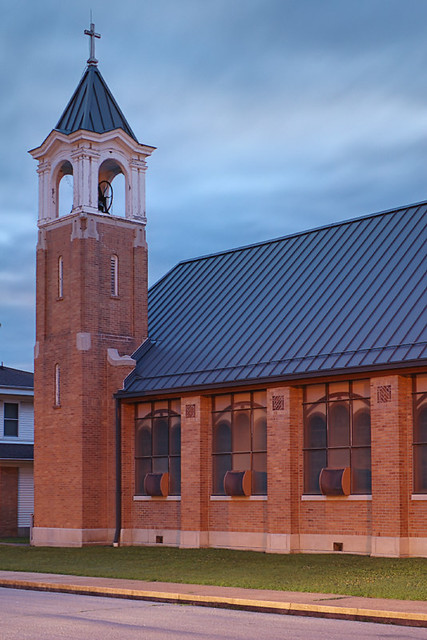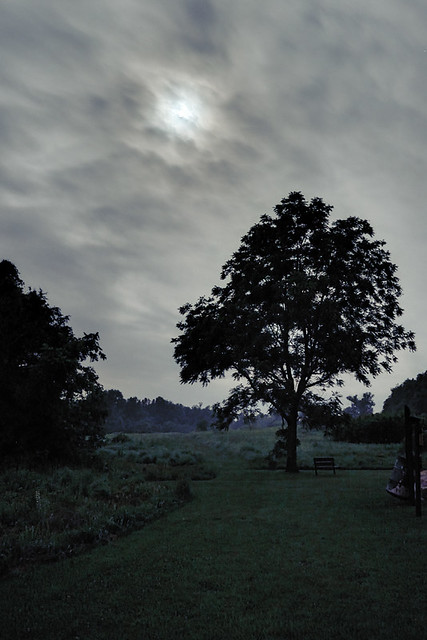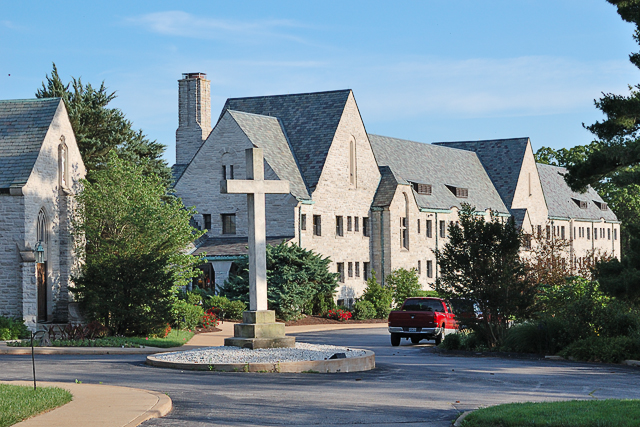Monday, June 27, 2011
Cdl. Burke's Homily at the Cathedral Basilica
Click here for Cardinal Burke's homily for Corpus Christi, at the Cathedral Basilica of Saint Louis.
Feast of Our Mother of Perpetual Help
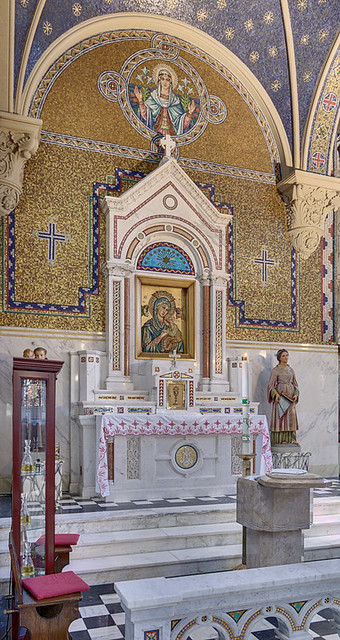
Altar with icon of Our Mother of Perpetual Help, at Saint Cecilia Church, in Saint Louis, Missouri. Photo taken in 2008.
The icon of Our Mother of Perpetual Help, also known as Our Lady of Perpetual Succor or the Theotokos of the Passion, is likely the best-known icon in the Latin Church. According to the Catholic Encyclopedia:
The picture of Our Lady of Perpetual Succour is painted on wood, with background of gold. It is Byzantine in style and is supposed to have been painted in the thirteenth century. It represents the Mother of God holding the Divine Child while the Archangels Michael and Gabriel present before Him the instruments of His Passion. Over the figures in the picture are some Greek letters which form the abbreviated words Mother of God, Jesus Christ, Archangel Michael, and Archangel Gabriel respectively. It was brought to Rome towards the end of the fifteenth century by a pious merchant, who, dying there, ordered by his will that the picture should be exposed in a church for public veneration. It was exposed in the church of San Matteo, Via Merulana, between St. Mary Major and St. John Lateran. Crowds flocked to this church, and for nearly three hundred years many graces were obtained through the intercession of the Blessed Virgin. The picture was then popularly called the Madonna di San Matteo. The church was served for a time by the Hermits of St. Augustine, who had sheltered their Irish brethren in their distress. These Augustinians were still in charge when the French invaded Rome (1812) and destroyed the church. The picture disappeared; it remained hidden and neglected for over forty years, but a series of providential circumstances between 1863 and 1865 led to its discovery in an oratory of the Augustinian Fathers at Santa Maria in Posterula.The original icon came from Crete, and has a long series of icons for its inspiration, and in turn has inspired uncountable copies and derivatives. According to tradition, the root of this artistic representation goes back to Saint Luke the Evangelist, who is said to have painted a portrait of the Blessed Virgin: this circular painting of Mary's face is found at the Abbey of Montevergine in Italy.
Artistically speaking, it is very difficult to satisfactorily compose an image of two persons together, but the many icons of the Virgin and Divine Child Jesus, such as this one, are supremely admirable for doing so in a pleasing manner.
According to Saint Alphosus Ligouri, founder of the religious order that now has custody of the original icon:
So great is the authority that mothers possess over their sons, that even if they are monarchs, and have absolute dominion over every person in their kingdom, yet never can mothers become the subjects of their sons. It is true that Jesus now in Heaven sits at the right of the Father, enjoying that distinction even as Man because of the hypostatic union with the Person of the Divine Word.Mater de Perpetuo Succursu, ora pro nobis!
He has supreme dominion over all and also over Mary; nevertheless, it can always be said that for a time at least, when He was living in this world, He was pleased to humble himself and be subject to Mary. Says St. Ambrose, Jesus Christ having deigned to make Mary His Mother, inasmuch as He was her Son, He was truly obliged to obey her. And for this reason, says Richard of St. Laurence, "Of other Saints we say that they are with God; but of Mary alone can it be said that she was so far favored as to be not only herself submissive to the will of God, but even that God was subject to her will.
Therefore we say that, even though Mary can no longer command her Son, since they are not on earth any more, still her prayers are always the prayers of a Mother and are therefore most powerful in obtaining whatever she asks.
Friday, June 24, 2011
Newsletter from the Oratory
|
Thursday, June 23, 2011
Photos at Sac Prairie
AN EXCERPT from A Summer Journey in the West, 1841, by Eliza R. Steele:

In French, the word prairie means meadow, and it was in this sense that the grasslands of the American mid-west were originally named by the colonial settlers. The Sac Prairie shown here is a meadow in the forested and rugged Lincoln Hills, an isolated Ozark-like region otherwise surrounded by flatter grassland.


The above photos were taken at the Sac Prairie in that park, and the flower below was taken on the hillside above.

See also the article Mushrooms and Moss, which has more photos from this day.
July 7th.—I fell asleep, and when I was awakened at dawn this morning, by my companion, that I might not lose the scene, I started with surprise and delight. I was in the midst of a prairie! A world of grass and flowers stretched around me, rising and falling in gentle undulations, as if an enchanter had struck the ocean swell, and it was at rest forever. Acres of wild flowers of every hue glowed around me, and the sun arising from the earth where it touched the horizon, was 'kissing with golden face the meadows green.'* What a new and wonderous world of beauty! What a magnificent sight! Those glorious ranks of flowers! Oh that you could have 'one glance at their array!' * How shall I convey to you an idea of a prairie. I despair, for never yet hath pen brought the scene before my mind. Imagine yourself in the centre of an immense circle of velvet herbage, the sky for its boundary upon every side; the whole clothed with a radiant efflorescence of every brilliant hue. We rode thus through a perfect wilderness of sweets, sending forth perfume, and animated with myriads of glittering birds and butterflies :—The following photos were taken at Cuivre River State Park, near Troy, Missouri:
"A populous solitude of bees and birds,It was, in fact, a vast garden, over whose perfumed paths, covered with soil as hard as gravel, our carriage rolled through the whole of that summer day. You will scarcely credit the profusion of flowers upon these praries. We passed whole acres of blossoms all bearing one hue, as purple, perhaps, or masses of yellow or rose; and then again a carpet of every color intermixed, or narrow bands, as if a rainbow had fallen upon the verdant slopes. When the sun flooded this Mosaic floor with light, and the summer breeze stirred among their leaves, the irredescent glow was beautiful and wonderous beyond any thing I had ever conceived. I think this must have been the place where Armida planted her garden, for she surely could not have chosen a fairer spot. Here are
And fairy formed, and many colored things." *
'Gorgeous flowrets in the sun light shining,The gentle undulating surface of these prairies, prevent sameness, and add variety to its lights and shades. Occasionally, when a swell is rather higher than the rest, it gives you an extended view over the country and you may mark a dark green waving line of trees near the distant horizon, which are shading some gentle stream from the sun's absorbing rays, and thus, 'Betraying the secret of their silent course.' * Oak openings also occur, green groves, arranged with the regularity of art, making shady, alleys, for the heated traveller. What a tender benevolent Father have we, to form for us so bright a world! How filled with glory and beauty must that mind have been, who conceived so much loveliness! If for his erring children he has created so fair a dwelling place, how well adorned with every goodly show, must be the celestial home reserved for his obedient people. Eye hath not seen it—ear hath not heard it—nor can it enter into our hearts to conceive it. *
Blossoms flaunting in the eye of day;
Tremulous leaves, with soft and silver lining
Buds that open only to decay.' *
Wondrous truths, and manifold as wondrous,
God hath written in those stars above—
But not less in the bright flowrets under us,
Stands the revelation of his love. *

In French, the word prairie means meadow, and it was in this sense that the grasslands of the American mid-west were originally named by the colonial settlers. The Sac Prairie shown here is a meadow in the forested and rugged Lincoln Hills, an isolated Ozark-like region otherwise surrounded by flatter grassland.


The above photos were taken at the Sac Prairie in that park, and the flower below was taken on the hillside above.

See also the article Mushrooms and Moss, which has more photos from this day.
Monday, June 20, 2011
Photos of Holy Angels (former Saint Bernard) Church, in Wood River, Illinois
HERE ARE PHOTOS of Holy Angels Church of the Diocese of Springfield in Illinois. The church is located about 20 road miles northeast of downtown Saint Louis in Wood River, Madison County, Illinois. Originally founded as Saint Bernard Church, it merged in the year 2005 with Saint Kevin Church in East Alton.

As far as I can tell, Saint Bernard was founded in 1919; this church building appears to date from the late 1950s or early 1960s. Unfortunately I was unable to find any more information on the history of this church.
Wood River gets its name from la rivière du Bois — French for ‘Wood River’ or ‘Wood Creek’. This swampy watercourse is known locally as Wood River Creek. Here was the site of Camp Dubois, the starting point for the famed Lewis and Clark expedition to explore the Louisiana Purchase. Here also was the site of the Wood River massacre during the war of 1812.
In 1907 Standard Oil commenced construction on a refinery here; workers originally commuted by street car from Saint Louis, but towns quickly sprung up around the refinery, including the neighborhood called Little Italy, which was the home for Italian and Croatian workers and their families, while Benbow City was known for its lawlessness, saloons, gambling, and disreputable houses.
Standard Oil intended that Wood River be a model city, and it purchased numerous Sears Catalog homes. Although the refinery closed in 1981, the Wood River area remains highly industrialized.
For more historical information see the website for the Wood River Heritage Council.
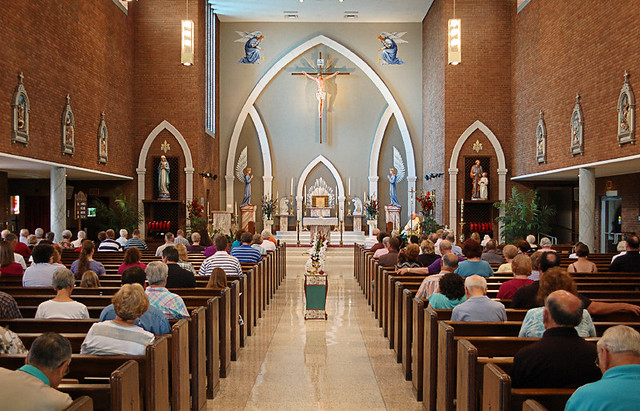
I was traveling in the area, and noticed this church on my GPS. I arrived at the church soon after the beginning of Holy Mass. I took this photo through the glass door in the narthex.
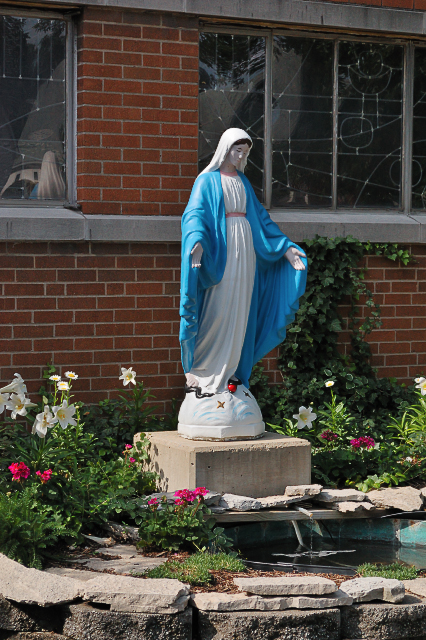
Marian garden outside of the church.

In the narthex is this plaque showing the history of the parish merger.
Address:
345 East Acton Avenue
Wood River, Illinois 62095
Saturday, June 18, 2011
Thursday, June 16, 2011
Thank You
I WOULD LIKE to thank my family, friends, and very many online friends who wished me a happy birthday yesterday.

I had the best birthday in years!
Yesterday was also the eighth anniversary of my Confirmation. Deo gratias!

I had the best birthday in years!
Yesterday was also the eighth anniversary of my Confirmation. Deo gratias!
Tuesday, June 14, 2011
Sunday, June 12, 2011
Pentecost
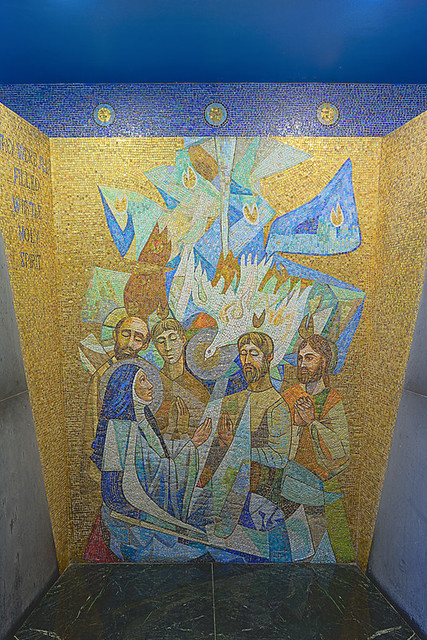
Send forth Thy Spirit, and they shall be created, and Thou shalt renew the face of the earth. Alleluia.
Mosaic at the Shrine of Our Lady of the Snows, in Belleville, Illinois.
Saturday, June 11, 2011
Higgs Boson Not Found
HIGH ENERGY PHYSICISTS are disappointed at the lack of evidence for the elusive Higgs boson. Fermilab, a laboratory in the western suburbs of Chicago, Illinois, recently discovered an unexplained signal, which some had hoped to be the long-sought-after Higgs boson, but subsequent analysis disproves this. See the article Tevatron's DZero Cannot Find New Particle.
The Higgs boson is a theoretical consequence of the Standard Model of physics, a theory which unifies three of the four known fundamental forces in the cosmos: the strong nuclear force (which explains nuclear energy), the electromagnetic force (which explains electricity, magnetism, light, and the basics of chemistry), and the weak force (which explains a particular kind of radioactivity). Fundamental particles predicted by the Standard Model include the electron (familiar as the carrier of electricity) and the photon, which is an irreducibly small particle of light (The existence of photons leads to noise in digital photography). Other predicted particles include the quarks, which make up the familiar protons and neutrons found in the nuclei of atoms. All of the particles predicted by the Standard Model have been discovered — except the Higgs boson. As far as I know, no subatomic particle has ever been found which cannot be explained by the Standard Model.
The Standard Model does not contain an explanation of gravitation: the best current theory is Einstein's General Theory of Relativity; however, unlike the Standard Model, general relativity is not compatible with quantum mechanics. A logical extension of the ordinary classical or Newtonian mechanics on a very small scale, quantum mechanics posits that energy is not infinitely divisible, but rather is bound up in quanta, or small packets. [Back when I was at Caltech, I proposed doing some research in the interaction of relativity and quantum mechanics, but was told not to bother with it, because my proposal threw out lots of the accepted theory of that era.]
The Standard Model was developed in the 1960s and is based on symmetry arguments. From the 1920s through the 1960s, experimenters had discovered a wild variety of subatomic particles, and many despaired of the fundamental idea that nature is ultimately simple. Eventually attempts were made to put these particles in a rational order. In chemistry, the development of the Periodic Table of the Elements immediately led to the prediction of previously unknown elements, which were indeed discovered either in nature or subsequently synthesized. Likewise, the development of the Standard Model led to the prediction of various subatomic particles — and multiple researchers quickly proposed the existence of what is now called the Higgs boson.
Since the Higgs boson has the interesting property of giving mass to the other particles in the Standard Model, it is quite important to our theoretical understanding of the cosmos. The existence of the Higgs boson explains a lot; the non-existence of the Higgs boson means that some other theory, such as a quantum gravity theory, is needed to explain the existence of mass.
The Higgs boson is often referred to in the press as the ‘God particle’, an unfortunate name taken from a popular science book. That name comes from the theory of materialistic monism, a theory that states that the observable cosmos is all that exists; and this monism is at the core of much modern scientific and secularistic thought — even American public school pedagogy is based on materialistic monism.
The rational consideration of existence goes by the name metaphysics. Nowadays that word has an irrational New Age connotation, and this is partially due to Catholic universities denigrating the study of metaphysics in favor of more worldly and materialistic philosophies; nature abhors a vacuum, and so the word metaphysics was taken over by others. However, metaphysics is a good solid subject: it merely asks the questions ‘what exists?’ and ‘what is it like?’ The existence of the Higgs boson is a currently a metaphysical question, as is the question of the validity of the Standard Model.
The standard history of science ends with Democritus and restarts again with Galileo, ignoring everything from Plato through the Medieval schoolmen. But we can still learn things from these ancient thinkers. In particular, we can consider the Catholic notion of the Great Chain of Being, which posits — via an argument of fittingness — a hierarchical structure of all that exists, which starts from God and continues down through inanimate matter.
The Chain of Being ends in fundamental matter, which is quite remote from the Source of all being. With matter being so remote, it is fitting to assume that the properties of fundamental matter are very simple, and get simpler the closer we look. So the wild variety of chemistry devolves to a simpler set of chemical elements, which are made up of simpler, well-ordered particles; these particles are vast in number, but are reduced to a small collection as described by the Standard Model. The existence of the Periodic Table of Elements is not in dispute, while the existence of the Standard Model remains a metaphysical problem.
As we go all the way down the chain, we ought to find simpler models with simpler interactions, which display greater symmetry — models that mathematical physicists call beautiful. Beauty is a great organizing principle in fundamental physics, with the more beautiful models having a greater likelihood of being true. Beauty and simplicity was one of the factors which led to the acceptance of the Standard Model.
As we move up the chain of being, these symmetries are broken, and things get messier. The periodic table of elements gets messier as the elements get heavier, chemicals have more complexity as they get larger, and living things get more complicated as they go up the chain: protozoa are more more complicated than viruses; fungi are more complicated than protozoa; plants are more complicated than fungi; higher animals are more complicated than lower; and rational animals (which as far as we know only consists of Man) are the most complicated beings in existence. Consider the existence of sexuality — what is pretty simple in lower orders becomes highly messy in human beings.
Platonic and Catholic philosophy also posits the existence of a higher order of being beyond the material world — a metaphysical, intellectual, or spiritual world. It is beyond and above mere matter, and is outside of space and time. Rational animals are seen as straddling these two worlds, being both material and simultaneously spiritual.
Part of the order of being in the metaphysical realm is mathematics. According to Plato, an understanding of mathematics is a great step towards enlightenment — for example, being able to see with the mind's eye, a true, mathematically perfect triangle, beyond the mere material drawn copies of triangles. Because math exists outside of space, time, and matter, it is a reliably true guide to understanding the material world; this is implicit in the modern sciences, especially in physics.
In his parables of the divided line and the cave, Plato asks us to go beyond mere opinion to more solid reality, which includes science of the material world, and mathematics in the metaphysical world — and even higher. Sadly, so many people live and die because of mere changeable opinion, with the most opinion-bound and power-hungry people being the worst of humanity. We can break the chains of this bondage to opinion by rising to contemplate higher things.
As we ascend into the higher realms, things get simpler. Angels and demons, having intellect but lacking bodies, are simpler than humans. Mathematics is extremely complicated, but less complicated than human psychology, and the logical foundations of math are much simpler than say, non-linear mathematical analysis. We reach ultimate simplicity when we rise to the Source, or God. Spiritual directors say that living an excessively complicated life is problematic, and that simplifying your life (in the upwards direction) is key to ultimate blessedness.
God is not a particle, but the existence of the Higgs boson is still an important metaphysical question.
The Higgs boson is a theoretical consequence of the Standard Model of physics, a theory which unifies three of the four known fundamental forces in the cosmos: the strong nuclear force (which explains nuclear energy), the electromagnetic force (which explains electricity, magnetism, light, and the basics of chemistry), and the weak force (which explains a particular kind of radioactivity). Fundamental particles predicted by the Standard Model include the electron (familiar as the carrier of electricity) and the photon, which is an irreducibly small particle of light (The existence of photons leads to noise in digital photography). Other predicted particles include the quarks, which make up the familiar protons and neutrons found in the nuclei of atoms. All of the particles predicted by the Standard Model have been discovered — except the Higgs boson. As far as I know, no subatomic particle has ever been found which cannot be explained by the Standard Model.
The Standard Model does not contain an explanation of gravitation: the best current theory is Einstein's General Theory of Relativity; however, unlike the Standard Model, general relativity is not compatible with quantum mechanics. A logical extension of the ordinary classical or Newtonian mechanics on a very small scale, quantum mechanics posits that energy is not infinitely divisible, but rather is bound up in quanta, or small packets. [Back when I was at Caltech, I proposed doing some research in the interaction of relativity and quantum mechanics, but was told not to bother with it, because my proposal threw out lots of the accepted theory of that era.]
The Standard Model was developed in the 1960s and is based on symmetry arguments. From the 1920s through the 1960s, experimenters had discovered a wild variety of subatomic particles, and many despaired of the fundamental idea that nature is ultimately simple. Eventually attempts were made to put these particles in a rational order. In chemistry, the development of the Periodic Table of the Elements immediately led to the prediction of previously unknown elements, which were indeed discovered either in nature or subsequently synthesized. Likewise, the development of the Standard Model led to the prediction of various subatomic particles — and multiple researchers quickly proposed the existence of what is now called the Higgs boson.
Since the Higgs boson has the interesting property of giving mass to the other particles in the Standard Model, it is quite important to our theoretical understanding of the cosmos. The existence of the Higgs boson explains a lot; the non-existence of the Higgs boson means that some other theory, such as a quantum gravity theory, is needed to explain the existence of mass.
The Higgs boson is often referred to in the press as the ‘God particle’, an unfortunate name taken from a popular science book. That name comes from the theory of materialistic monism, a theory that states that the observable cosmos is all that exists; and this monism is at the core of much modern scientific and secularistic thought — even American public school pedagogy is based on materialistic monism.
The rational consideration of existence goes by the name metaphysics. Nowadays that word has an irrational New Age connotation, and this is partially due to Catholic universities denigrating the study of metaphysics in favor of more worldly and materialistic philosophies; nature abhors a vacuum, and so the word metaphysics was taken over by others. However, metaphysics is a good solid subject: it merely asks the questions ‘what exists?’ and ‘what is it like?’ The existence of the Higgs boson is a currently a metaphysical question, as is the question of the validity of the Standard Model.
The standard history of science ends with Democritus and restarts again with Galileo, ignoring everything from Plato through the Medieval schoolmen. But we can still learn things from these ancient thinkers. In particular, we can consider the Catholic notion of the Great Chain of Being, which posits — via an argument of fittingness — a hierarchical structure of all that exists, which starts from God and continues down through inanimate matter.
The Chain of Being ends in fundamental matter, which is quite remote from the Source of all being. With matter being so remote, it is fitting to assume that the properties of fundamental matter are very simple, and get simpler the closer we look. So the wild variety of chemistry devolves to a simpler set of chemical elements, which are made up of simpler, well-ordered particles; these particles are vast in number, but are reduced to a small collection as described by the Standard Model. The existence of the Periodic Table of Elements is not in dispute, while the existence of the Standard Model remains a metaphysical problem.
As we go all the way down the chain, we ought to find simpler models with simpler interactions, which display greater symmetry — models that mathematical physicists call beautiful. Beauty is a great organizing principle in fundamental physics, with the more beautiful models having a greater likelihood of being true. Beauty and simplicity was one of the factors which led to the acceptance of the Standard Model.
As we move up the chain of being, these symmetries are broken, and things get messier. The periodic table of elements gets messier as the elements get heavier, chemicals have more complexity as they get larger, and living things get more complicated as they go up the chain: protozoa are more more complicated than viruses; fungi are more complicated than protozoa; plants are more complicated than fungi; higher animals are more complicated than lower; and rational animals (which as far as we know only consists of Man) are the most complicated beings in existence. Consider the existence of sexuality — what is pretty simple in lower orders becomes highly messy in human beings.
Platonic and Catholic philosophy also posits the existence of a higher order of being beyond the material world — a metaphysical, intellectual, or spiritual world. It is beyond and above mere matter, and is outside of space and time. Rational animals are seen as straddling these two worlds, being both material and simultaneously spiritual.
Part of the order of being in the metaphysical realm is mathematics. According to Plato, an understanding of mathematics is a great step towards enlightenment — for example, being able to see with the mind's eye, a true, mathematically perfect triangle, beyond the mere material drawn copies of triangles. Because math exists outside of space, time, and matter, it is a reliably true guide to understanding the material world; this is implicit in the modern sciences, especially in physics.
In his parables of the divided line and the cave, Plato asks us to go beyond mere opinion to more solid reality, which includes science of the material world, and mathematics in the metaphysical world — and even higher. Sadly, so many people live and die because of mere changeable opinion, with the most opinion-bound and power-hungry people being the worst of humanity. We can break the chains of this bondage to opinion by rising to contemplate higher things.
As we ascend into the higher realms, things get simpler. Angels and demons, having intellect but lacking bodies, are simpler than humans. Mathematics is extremely complicated, but less complicated than human psychology, and the logical foundations of math are much simpler than say, non-linear mathematical analysis. We reach ultimate simplicity when we rise to the Source, or God. Spiritual directors say that living an excessively complicated life is problematic, and that simplifying your life (in the upwards direction) is key to ultimate blessedness.
God is not a particle, but the existence of the Higgs boson is still an important metaphysical question.
Thursday, June 09, 2011
Eucharistic Congress
A NOTE FROM the Archdiocese of Saint Louis:
Newsletter from the Oratory
 SAINT FRANCIS DE SALES ORATORY EMAIL NEWSLETTER 2653 Ohio Avenue Saint Louis, Missouri 63118 www.institute-christ-king.org www.TraditionForTomorrow.com 314-771-3100 | ||
|
Tuesday, June 07, 2011
"Unhappy Hipsters"
HAVING FREED THEMSELVES from the tyranny of the past, architects are no longer limited to the classical orders and to traditional methods, and can embrace new materials and new designs in order to create a more perfect future. But what are the results of this freedom? Why do we so often have a dreary sameness in new designs?
I recently rediscovered the blog Unhappy Hipsters, started last year, which documents the new paradigm of residential architecture, and the people who dwell within. What is odd about these photos is that the people here almost always appear to be unhappy and lonely — and so the anonymous author supplies unpleasant captions to explain what might be going on.

Every once in a while she’d allow herself the extravagance of an ever-so-brief glance at the outside world. [source]

With resignation she realized she did need rescuing; if not from herself, then from the punishing aesthetic of her life. [source]
The new artistic freedom was in fact not the freedom to do whatever is the right thing to do, but rather a ‘freedom’ from the old styles of the past. But what if the right thing to do is prohibited? Will we end up with homes that are depressing? It is no surprise that when you subtract history, you have practically nothing left, which is why these high-styled homes appear so similar to each other. Architects of antiquity, if they desired, could have built a blank wall, and undoubtably they did so, but they weren't limited to doing only that one thing. The photos on Unhappy Hipsters show a largely unvarying plainness that lacks much human quality.
There are a few architectural schools that are attempting to break this trend, such as at Notre Dame.
Sunday, June 05, 2011
The Universal Call to Holiness and the Third Order of Saint Francis
THE IDEA THAT everyone is called to live a life of holiness — not just those in religious life — is too often believed to be an innovation of the 20th century.
But this is not so.
Saint Basil the Great in the 4th century, Saint Alphonsus Maria de Liguori in the 18th, and Saint Francis de Sales in the 17th, all preached on the importance of living the Gospel no matter your state in life. So did Saint Francis of Assisi, in the 13th century.
Although Saint Francis is well-known for founding the religious institutes of the Friars Minor and the Poor Clares, he also founded a Third Order for lay persons.
From The Life and Legends of Saint Francis of Assisi by Father Candide Chalippe:
But this is not so.
Saint Basil the Great in the 4th century, Saint Alphonsus Maria de Liguori in the 18th, and Saint Francis de Sales in the 17th, all preached on the importance of living the Gospel no matter your state in life. So did Saint Francis of Assisi, in the 13th century.
Although Saint Francis is well-known for founding the religious institutes of the Friars Minor and the Poor Clares, he also founded a Third Order for lay persons.
From The Life and Legends of Saint Francis of Assisi by Father Candide Chalippe:
One day St. Francis having gone from Florence to Gagiano, near Poggibonzi, in Tuscany, met a shop-keeper of his acquaintance, whose name was Lucchesio, who had been very avaricious, and an enthusiastic partisan of the faction of the Guelphs, but who, having been converted a few months before, now lived a very Christian-like life, gave away great sums in alms, attended the sick in hospitals, received strangers hospitably into his house, and endeavored to instil similar sentiments into Bonadonna, his wife. They had already asked Francis to put them in a way of sanctifying their lives, which should be suitable to their position; and the holy man had given them this answer: "I have been thinking of late of instituting a Third Order, in which married persons might serve God perfectly; and I think you could not do better than to enter it." After having given the subject serious consideration, Lucchesio and his wife entreated him to admit them into this new Order. He made them assume a modest and simple dress, of a grey color, also a cord with several knots in it for a girdle, and he prescribed verbally certain pious exercises, which they were to follow until such time as he should have composed the rule.
This was the beginning of the Third Order of St. Francis, which many persons in the environs of Poggibonzi embraced, and which was soon established in Florence by the congregation of men and women of which we have just spoken. The following year, at latest, the Founder composed a rule for this Order, which he called the Order of the Brethren of Penance, in which the sisters were comprised, which was also called the Third Order, or the Order of Tertiaries, as relative to the two older Orders: the Order of Friars Minors, which is the first, and that of the Poor Clares, which is the second. This rule was subsequently confirmed by Pope Nicholas IV, and Leo XIII, with some changes, which they considered advisable as well in regard to the times as to the Order itself.
The holy Patriarch manifests therein not only the zeal which animated him in all that concerned the purity of the faith, but also the prudence which guided all his actions. He requires that all those who apply for admission into the Order shall be carefully examined in the Catholic faith, and their submission to the authority of the Church, and he directs that they shall only be received after having made profession of all the orthodox truths; and that great care shall be taken not to admit any heretic, nor any one suspected of heresy; and should any such be detected after having been admitted, he insists on their being immediately informed against. He, likewise, directs that their previous conduct may be inquired into, to ascertain whether any notorious crimes are imputed to them, or whether their morals are irreproachable, and he desires that they be warned to restore what they have which belongs to any other person; he also forbids receiving any married female into the Order without the consent of her husband.
The profession consists in a promise to keep all God's commandments, and to perform such penances as the visitor shall enjoin for faults committed in breach of the practices required by the rule. The habit is similar to what was given to Lucchesio and his wife; but so, that this may be dispensed with, according to the state of life of the persons, and the customs of the country in which they may be. The spiritual exercises laid down in the rule, have nothing in them which can interfere with the different stations of persons living in the world. Days of fasting and abstinence are prescribed, but modified prudently for the infirm, for pregnant women, for travellers, and for laboring people; and it is clearly explained that these observances are not obligatory under pain of sin, and that they only bind the transgressor to perform the penance imposed on him, unless the transgression has at the same time contravened any law of God, or commandment of the Church.
St. Francis, moreover, strenuously recommends to the brethren and sisters, to avoid all words tending to swearing or imprecation, the theatre, dancing, and all profane meetings; to undertake no law-suits, and to live in fraternal union; to take great care of the sick of the Order, to bury the dead, and to pray for them.
He adds to this, an article which is deserving of peculiar notice; it is, that all persons who enter the Order and have property over which they have the disposal, shall make their wills within a few months after their profession, lest they should die intestate. We see that his intention was to make them think on death, and to have their minds free for meditating on the important affair of their salvation, and to prevent those dissentions which frequently occur after the death of such as have not regulated their temporal affairs, before being called away. Wills which are made during a last illness are frequently exposed to deceit and fraud. They are never better made than when executed while the testator is in good health, in possession of all his faculties.
By the institution of the Third Order, Francis proposes to himself to reanimate the fervor of the faithful, to induce all the world, those in orders, laics [the laity], married persons of either sex, and such as were living in a state of celibacy, to a stricter observance of God's commandments, to live a more Christian and Catholic life, and to add the practice of virtues to the duties of civil life. His views met with astonishing success; the Order was established, and spread with the greatest rapidity through all conditions of life. Cardinals, bishops, emperors, empresses, kings, queens, considered themselves honored in being admitted into it, and it has given to the Church an infinite number of saints and blessed of either sex, who are publicly revered with her sanction. Wading says, that in his day, (that is in 1623,) there were at the court of Madrid more than sixty lords who belonged to the Third Order; and Cardinal Trejo, who had joined it, wrote to him in these terms on the subject of the works of St. Francis, which that author was about to give to the public with learned notes.
Saturday, June 04, 2011
Fountain Angel
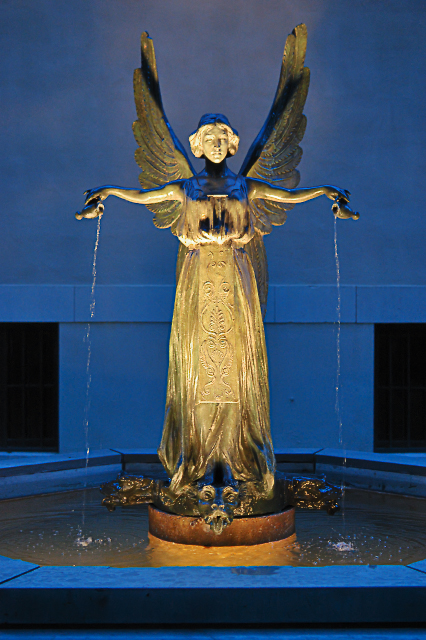
The Fountain Angel, circa 1902, by Raffaello Romanelli, at the Missouri Botanical Garden (Shaw's Garden), in Saint Louis, Missouri.
"the photo that moved me"
A touching article: the photo that moved me.
Thursday, June 02, 2011
Ascension Thursday
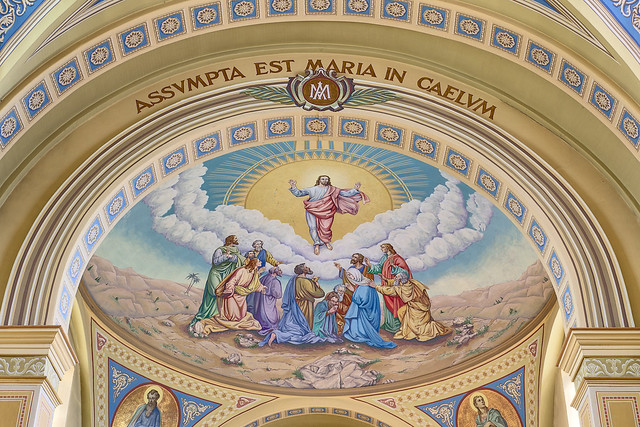
Painting of the Ascension of Our Lord, at Saint Mary of the Barrens Church, the National Shrine of Our Lady of the Miraculous Medal, in Perryville, Missouri.
Wednesday, June 01, 2011
New Geometric Patterned Art
SEE THESE new abstract floor tile patterns, in the article Thomas More College Students’ Art Work – Geometry, at The Way of Beauty and also here. Geometric tiled patterns became something of a lost art in the last century, but we will likely soon see a revival of this ancient form of abstract art. According to the article:
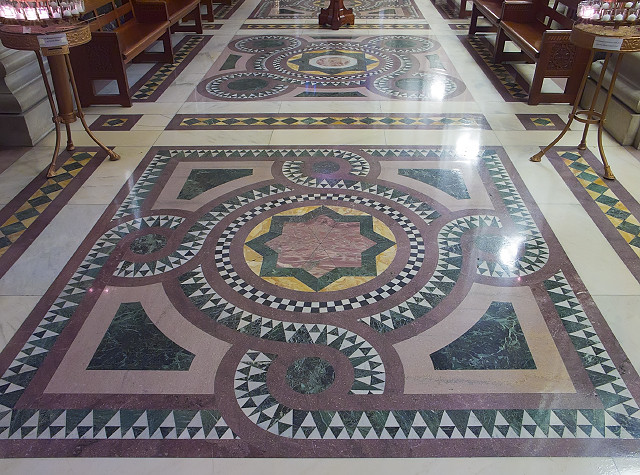
Here is an example of this kind of floor tiling, showing quincunxes, found at the Cathedral Basilica of Saint Louis.
The principles needed to create attractive geometric patterns are simple to learn and are ancient. Some of these rules can be found here, and the principles of Boethian proportion are also important. Some rules are indeed social convention, and an artist making art for a Catholic church ought to follow the Church's conventions. But other rules are akin to laws of nature: color is rather subjective yet still follows laws, while geometry has a truth that transcends nature and so cannot be violated.
Simple geometric construction techniques are essential for creating interesting and visually harmonic patterns. But these techniques are not necessarily apparent on visual inspection of a finished work.
Then I set the students a project to create a design for either the floor of nave or sanctuary in a simple basilica style church... The results are very impressive. After one semester they are producing church floor designs that would grace any church in the country and which are more involved than most churches built in the last hundred years at least.

Here is an example of this kind of floor tiling, showing quincunxes, found at the Cathedral Basilica of Saint Louis.
The principles needed to create attractive geometric patterns are simple to learn and are ancient. Some of these rules can be found here, and the principles of Boethian proportion are also important. Some rules are indeed social convention, and an artist making art for a Catholic church ought to follow the Church's conventions. But other rules are akin to laws of nature: color is rather subjective yet still follows laws, while geometry has a truth that transcends nature and so cannot be violated.
Simple geometric construction techniques are essential for creating interesting and visually harmonic patterns. But these techniques are not necessarily apparent on visual inspection of a finished work.
Cicadas
Cicadas have made their periodic appearance in this part of the world. This video gives you a tiny glimpse at the huge numbers of these insects that are found now. Turn your volume up all the way for the best effect — these bugs are nearly deafening.
Subscribe to:
Comments (Atom)











